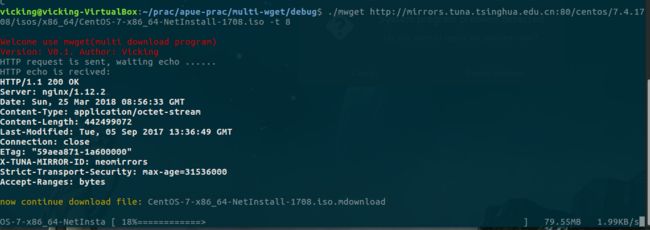Linux下多线程下载兼断点续传实现-原创
原文在我的个人网站上:http://www.vicking.pw/?p=155
C 语言也能干大事啊,下面是我写的一个运行在linux下的多线程下载并有断点续传的功能的程序,花了三天时间,不吃不喝,累死我了。不过终于写出来了,一些基本的bug已经去除了。然后其他的问题希望大家多多测试哈,问题发送到我的邮箱来:[email protected]
多线程下载 并支持 断点续传 程序(类unix下终端程序)
名称:mwget
版本:V0.1
开发者:Vicking
开发周期:2018-3-22至2018-3-25
github地址: https://github.com/shengliwang/mwget
使用方法
./mwget URL [-t 线程数] [-o 保存的文件名] 如果不指定线程数则使用单线程,不指定文件名,则使用服务器端的名字
软件的一个截屏:
一、开发总体思路如下:
1,根据用户指定的URI来分析文件大小。
2,根据用户指定的线程数来创建线程分段下载整个文件,最后合并起来。
3,需要指示出下载进度,下载完成时所用的时间
4,需要指定本程序应用的范围:如https不可下载
二、程序编写及运行具体过程
1,包含相应的头文件
2,定义宏来指定程序版本, 作者
3, main函数
4,分析用户指定参数(如果条件不合适,则打印出错信息并退出):
创建一个结构体cmd用来保存初始化后的参数
分析函数应找出使用的为http协议,其他协议目前不支持,应给出提示信息并退出
分析函数提取server的FQDN名称转化成整形的ipv4地址,ipv6地址目前不支持,如果为ipv6,给出信息并退出
分析函数应提取server的端口号,如果没有指定端口,则使用默认端口80
分析函数应提取获取文件的名字,如果没有名字,则默认获取index.html并给出提信息
分析函数应提取下载文件另存为的文件名字,如果没有,则用上面的sever端名字
分析函数应提取下载所用的线程数,如果没有指定,则使用单线程下载,限定使用下载线程数不能超过定义的MAX_THREAD_NUM宏(util.c)
5,根据分析用户指定的参数(命令行参数)获取到了server端的ip地址和端口号,以及要下载的文件的长度信息,和使用的线程数
创建一个函数, 此函数应先发出HTTP 的 HEAD报文获取要获得的文件长度 (顺便测试服务器能不能正常连上,不行的话则报错退出 . 1)、先比较状态码,不正确则报错退出 2)、然后找长度,找不到,则退出并报错)
6, 上面初始化工作结束后,下载之前应输出如下信息,此程序名称,版本号,开发者,使用线程数,server端信息,下载文件名称,存储文件名称,
7,创建多个线程进行下载 (通过cfg配置文件进行线程间通讯,其中包含完成进度信息)
每个线程中应有一个变量用来表示线程完成的进度(创建线程的时候传入),每个线程完成一次read和write后对这个变量进行增加
在主线程中实现一个函数,用来检测这些变量的值,然后跟文件总长度做比较,给出进度条
8,测试是否进行断点续传
1, cfg 文件保存未完成下载的download文件的一些信息(如线程个数,已完成的长度),用于断点续传
1, 创建通用的线程函数,用于重头下载和续传的两种模式,只要提交给他任务就行
2, 检测是否断点续传的情况 (创建函数进行测试)
1)、 download文件不存在,重头下载。
2)、检测到download文件存在,cfg文件不存在,重新下载,并提示用户是否覆盖download文件,不覆盖则退出。
3)、检测到download文件存在,cfg存在,则判断cfg文件能用否(cfg文件以yes开头能用,并且起大小是某个信息结构体的整数倍,程序中有说明),
1>>能用,则判断download文件大小是否正确,不正确提示覆盖,重头下载,正确则续传
2>>不能用,报错,并重头下载,并且覆盖cfg文件。
10, 回收线程:
可以根据线程退出值来判断下载线程有没有执行成功,如果不能执行成功(下载线程返回非NULL值),则整个进程退出,并提示用户重新启动本程序,断点续传。
遇到的问题
就是在线程函数发送请求时,收不到服务器的回应,用tcpdump抓包发现,发送的报文不完全,原来是request的的长度太短了(原来为128)。改长后就正常了。(如下抓的报部分)
数据请求部分
192.168.2.102.52142 > 101.6.8.193.80: Flags [P.], cksum 0x317c (incorrect -> 0xa6a5), seq 0:128, ack 1, win 229, options [nop,nop,TS val 3963801377 ecr 3603563775], length 128: HTTP, length: 128
GET /centos/7.4.1708/isos/x86_64/CentOS-7-x86_64-NetInstall-1708.iso HTTP/1.1
Range: bytes=0-442499071
Host: mirrors.tuna.tsin[!http] // 发送的请求到此结束(粗体),可见没有发送完全
//对比程序中对rquest的构建,request一共128字节,sprintf导致部分数据没有被request数组保存,所以把request调大即可
首先放上makefile(# 注意: 每个编译都加了-g,代表是debug版本,如果想要release版本,把每个编译的-g 去除即可)(另外这是一个非常简单非常low的写法,哈哈)
all:wrap/wrap.o main.o util.o test_continue.o thread_download.o print_scheduler.o thread_join.o
gcc debug/wrap.o debug/main.o debug/util.o debug/test_continue.o \
debug/thread_download.o debug/print_scheduler.o debug/thread_join.o -g -pthread -o debug/mwget
thread_join.o:thread_join.c
gcc thread_join.c -c -g -pthread -o debug/thread_join.o
print_scheduler.o:print_scheduler.c
gcc print_scheduler.c -c -g -o debug/print_scheduler.o
wrap/wrap.o: wrap/wrap.c
gcc wrap/wrap.c -c -g -o debug/wrap.o
main.o: main.c
gcc main.c -c -g -o debug/main.o
util.o: util.c
gcc util.c -c -g -o debug/util.o
test_continue.o: test_continue.c
gcc test_continue.c -c -g -o debug/test_continue.o
thread_download.o: thread_download.c
gcc thread_download.c -c -g -o debug/thread_download.o
clean:
rm -f debug/*
rm -f debug/.*.cfg下面一步一步来讲解本程序的工作原理
main.c
#include util.c (里面包含初始化函数: init_args 和获取文件长度的函数get_file_length)
/* util.c */
#include test_continue.c 测试是否进行续传的函数
#include "util.h"
#include thread_download.c : 里面由用于下载的线程函数
#include "util.h"
#include print_scheduler.c : 用于打印进度条的函数实现
#include thread_join.c : 用于回收下载线程的的线程函数实现,注意:主线成另外创建一个线程用来回收下载线程,所以程序运行实际使用的线程数为-t 指定的线程数+2, 主线程用来打印进度条
#define _GNU_SOURCE
#include 